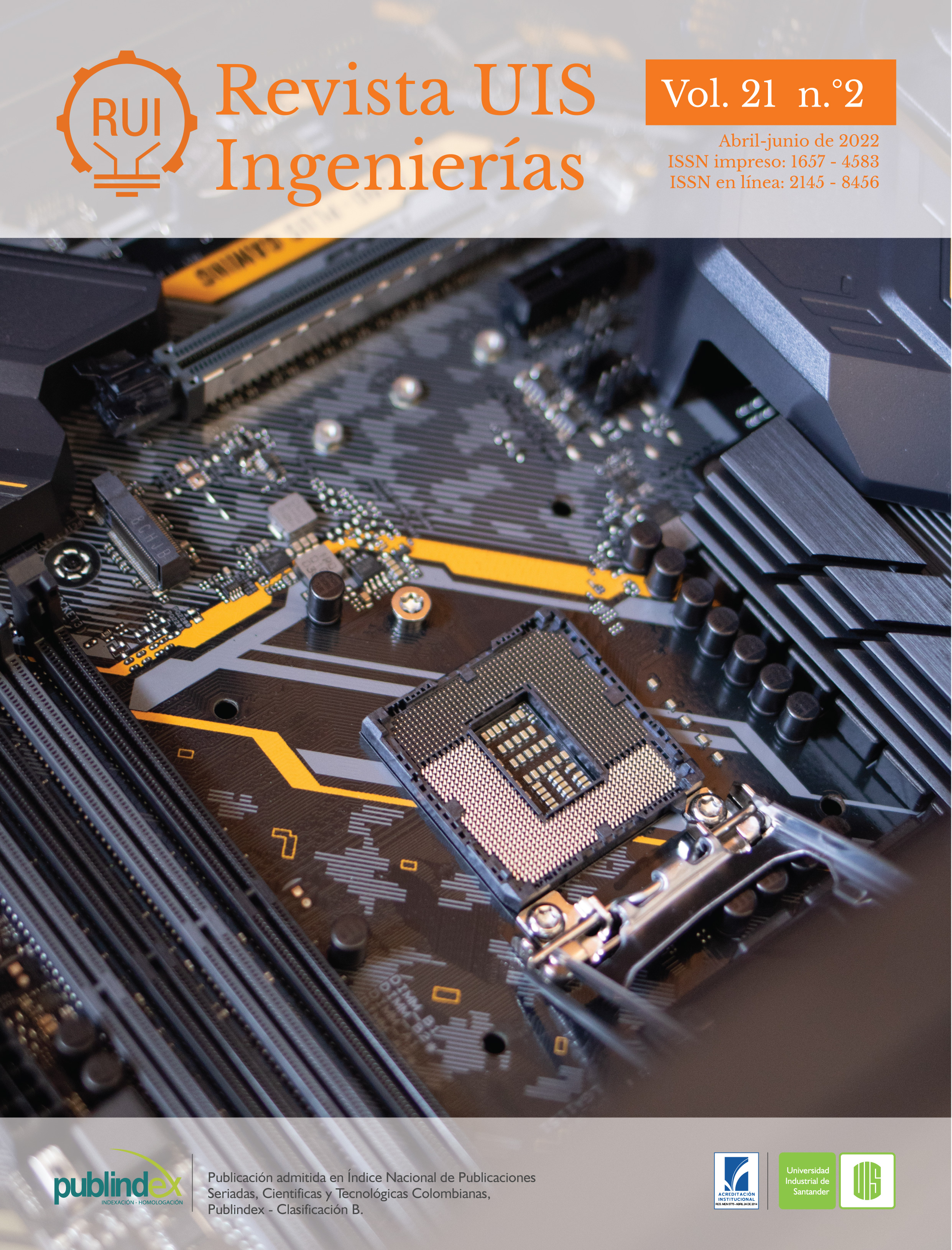Experimental and numerical evaluation of the use of recycled rubber as elastomeric bearing in simply supported bridge models
Published 2022-05-16
Keywords
- recycled rubber,
- finite elements,
- elastomeric bearings,
- mechanical behavior
How to Cite
Copyright (c) 2022 Revista UIS Ingenierías

This work is licensed under a Creative Commons Attribution-NoDerivatives 4.0 International License.
Abstract
Nowadays, construction is one of the activities with the greatest impact, the reason why it is necessary to look for materials that contribute favorably to the environment. With this premise, this article studies the implementation of recycled tire rubber as elastomeric support in simply supported beams. For this purpose, three physical models of reinforced concrete bridges with different bearing types were developed: 1) without bearings, 2) neoprene bearings, and 3) recycled rubber bearings, which were subjected to a horizontal vibration test. Subsequently, there was a development of numerical models equivalent to physical tests, and it was determined the influence of the use of recycled rubber bearings on the mechanical behavior of the structural elements. The results indicate that the implementation of recycled rubber sheets as bearings elements produces a reduction in the internal forces of the structural elements and show an increase in the displacement of the models. The obtained results allow us to conclude that recycled rubber sheets could be used in the construction of bearings for bridge structures.
Downloads
References
- X. Li, T. Ling, K. Mo, “Functions and impacts of plastic/rubber wastes as eco-friendly aggregate in concrete – A review”, Construction and Building Materials, vol. 240, p. 117869, 2020, doi: https://doi.org/10.1016/j.conbuildmat.2019.117869
- C. Albano, N. Camacho, M. Hernández, A. Bravo, H. Guevara, “Estudio de concreto elaborado con caucho de reciclado de diferentes tamaños de partículas”, Revista de la Facultad de Ingeniería Universidad Central de Venezuela, vol. 23, pp. 67-75, 2008.
- M. Alonso, M. Viola, “Estudio de factibilidad técnica, económica y financiera de una planta de reciclado de neumáticos fuera de uso”, trabajo de grado, Universidad Argentina de la Empresa, Buenos Aires, 2013.
- Mezclas asfálticas en caliente con asfaltos modificados con caucho por vía húmeda, Instituto de Desarrollo Urbano, Bogotá D. C., Sección 560-11, 2011.
- LRFD Bridge Design Specifications, AASHTO, Washington D. C., USA, 2020.
- Norma Colombiana de Diseño de Puentes CCP-14, INVIAS, Colombia, 2015.
- Y. Yuan, S. Wang, P. Tan, H. Zhu, “Mechanical performance and shear constitutive model study of a new high-capacity polyurethane elastomeric bearing”, Construction and Building Materials, vol. 232, p. 117227, 2020, doi: https://doi.org/10.1016/j.conbuildmat.2019.117227
- F. Consuegra, C. Santos, “Vibration analyses for the local and global evaluation of bridges as a tool for structural retrofit”, Revista de la Construcción, vol. 14, pp. 16-22, 2015.
- R. Avilés, “Dispositivos para el control de vibraciones”, trabajo de grado, Universidad Austral de Chile, 2001.
- L. Gartner, Y. Minota, “Evaluación preliminar del comportamiento de láminas de caucho reciclado como elemento de apoyo en modelos de vigas simplemente apoyadas sometidas a vibraciones horizontales”, trabajo de grado, Universidad Santo Tomás, Colombia, 2019.
- A. Camacho-Támara, H. Reyes-Pineda, A. Lozano-Bohórquez, “Análisis y caracterización fisicoquímica del látex de caucho especie Hevea Brasiliensis”, Revista Tumbaga, vol. 1, nº 9, pp. 83-97, 2014.
- L. Cardona-Gómez, L. Sánchez-Montoya, “Aprovechamiento de llantas usadas para la fabricación de pisos decorativos”, trabajo de grado, Universidad de Medellín, Colombia, 2011.
- M. Zarei, Z. Rahmani, M. Zahedi, M. Nasrollahi, “Technical, Economic, and Environmental Investigation of the Effects of Rubber Powder Additive on Asphalt Mixtures”, Journal of Transportation Engineering, Part B: Pavements, vol. 146, pp. 1-7, 2020, doi: https://doi.org/10.1061/JPEODX.0000142
- G. Peláez-Arroyave, S. Velásquez-Restrepo, D. Giraldo-Vásquez, “Aplicaciones de caucho reciclado: Una revisión de la literatura”, Ciencia e Ingeniería Neogranadina, vol. 27, nº 2, pp. 27-50, 2017, doi: https://doi.org/10.18359/rcin.2143
- G. Castro, “Reutilización, reciclado y disposición final de neumáticos”, Facultad de Ingeniería de la Universidad de Buenos Aires, Buenos Aires, 2007.
- F. López-Gómez, A. López-Delgado, F. Alguacil, J. Manso, “Situación actual del tratamiento de neumáticos fuera de uso y posibilidades de obtención de negro de humo de alta pureza”, Consejo Superior de Investigaciones Científicas, Madrid, España, 2009.
- C. Vallecilla, Fundamentos de diseño de puentes: Ejemplos resueltos. Colombia: Editorial Bauen, 2018.
- J. Zhao, D. Tonias, Bridge Engineering: Design, Rehabilitation, and Maintenance of Modern Highway Bridges. New York, USA: McGraw-Hill Education, 2017.
- J. Steelman, L. Fahnestock, E. Filipov, J. LaFave, J. Hajjar, D. Foutch, “Shear and Friction Response of Nonseismic Laminated Elastomeric Bridge Bearings Subject to Seismic Demands”, Journal of Bridge Engineering, vol. 18, pp. 612-623, 2013, doi: https://doi.org/10.1061/(ASCE)BE.1943-5592.0000406
- Standard Test Method for Rubber Property—Durometer Hardness, ASTM D2240-15, 2015, doi: https://doi.org/https://doi.org/10.1520/D2240-15
- Standard Test Methods for Vulcanized Rubber and Thermoplastic Elastomers—Tension, ASTM D412-16, 2021.
- J. Valdés, J. De la Colina, “Análisis de la Amplificación Dinámica de la Carga Viva en Puentes con Base en Pruebas Experimentales”, Revista Tecnológica - ESPOL, vol. 21, no. 1, pp. 149-156, 2008.
- M. Jara, J. Casas-Rius, Control de vibraciones en puentes: un estado del arte y de la práctica. España: Centro Internacional de Métodos Numéricos en Ingeniería, 2002.
- J. Kelly, D. Konstantinidis, Mechanics of rubber bearings for seismic and vibration isolation. West Sussex, UK: John Wiley & Sons, 2011.
- Y. Wu, H. Wang, A. Li, D. Feng, B. Sha, Y. Zhang, “Explicit finite element analysis and experimental verification of a sliding lead rubber bearing”, Journal of Zhejiang University-SCIENCE A, vol. 18, pp. 363–376, 2017, doi: http://doi.org/10.1631/jzus.A1600302
- E. Tubaldi, S. Mitoulis, H. Ahmadi, “Comparison of different models for high damping rubber bearings in seismically isolated bridges”, Soil Dynamics and Earthquake Engineering, vol. 104, pp. 329-345, 2018, doi: https://doi.org/10.1016/j.soildyn.2017.09.017
- Y. Zhang, J. Li, L. Wang, H. Wu, “Study on the Seismic Performance of Different Combinations of Rubber Bearings for Continuous Beam Bridges”, Advances in Civil Engineering, vol. 2020, p. 22, 2020, doi: https://doi.org/10.1155/2020/8810874
- N. Xiang, M. Shahria-Alam, J. Li, “Shake table studies of a highway bridge model by allowing the sliding of laminated-rubber bearings with and without restraining devices”, Engineering Structures, vol. 171, pp. 583-601, 2018, doi: https://doi.org/10.1016/j.engstruct.2018.05.121

